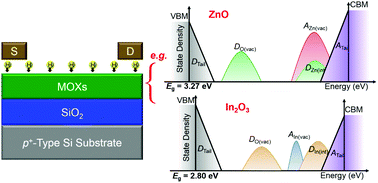Impact of hydrogen dopant incorporation on InGaZnO, ZnO and In2O3 thin film transistors†
Abstract
In this work, hydrogen (H) plasma treatment is implemented to dope indium gallium zinc oxide (InGaZnO), zinc oxide (ZnO), and indium oxide (In2O3) thin-film transistors (TFTs). We systematically analyze the active defect states inside these n-type metal oxides and reveal how they are impacted by H dopant incorporation, combining the device transfer characteristics (including the threshold voltage, subthreshold slope, and carrier mobility), the X-ray photoelectron spectra, and numerical and theoretical investigations. An increase of the field-effect mobility of these TFTs is mainly attributed to the decreased interface and bulk tail-distributed traps, after an appropriate amount of H dopants is incorporated. In ZnO, hydrogen exclusively acts as a shallow donor during the plasma treatment, while the zinc vacancies Zn(Vac) cannot be passivated by the H dopants as no improvement of the subthreshold slope (SS) is observed in the hydrogenated ZnO TFT. The H interstitials (Hi) incorporated into In2O3 are stable in the + charge state at equilibrium, then change into the − charge state as the Fermi level energy EF gets closer to the bottom of the conduction band. Due to the H insertion into an oxygen vacancy VO, the VOH complex (acting as an acceptor) is formed in InGaZnO with increased H plasma treatment duration, leading to the degraded SS. This paper clarifies the H dopants’ role and the different dominant defects inside the three types of TFTs, which may benefit systematic understanding and exploration of H dopant incorporation into InGaZnO, ZnO and In2O3 films for TFT improvement and optimization.



 Please wait while we load your content...
Please wait while we load your content...